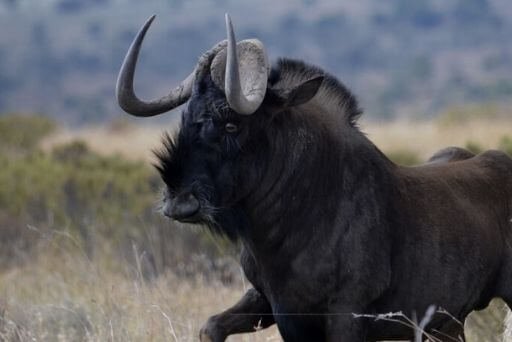Wildebeest – Have you ever heard of them?
The wildebeest is an animal that we often find in cartoons and children’s stories. Famous for its ox-like appearance, do we really know the wildebeest? Today, we are going to reconstruct, illustrate and represent what is this animal with horns and beard. In this article, you will discover the characteristics of this majestic animal.
The “Wildebeest” are also called ” Gnu”. These large herbivores walk in vast herds across the plains of Africa, always in search of nourishment and clean water. At the beginning of the rainy season, wildebeests begin their annual migration across East Africa, traveling a distance of between 500 and 1,000 miles each year.
This bovid with a heavy structure and large forequarters has a very large box-shaped head and smooth, sharp horns curved upwards. These horns grow on both males and females. Their hindquarters are slender as are the legs, which end in hooves. Its body is covered with a short gray coat and its face is “bearded”, that is, it has a long, shaggy mane that may be black or white. It has a wide snout, which allows it to consume short grass on the ground.
In their search for sufficient food sources to satisfy their appetite, wildebeests have to be constantly on the move. They are herbivorous animals that feed primarily on short grasses, but during the dry season, they consume tall grass. They drink water twice a day.

Wildebeest are migratory animals and are therefore, constantly on the move. In May or June, numerous herds and millions of individuals travel from dry areas to the north and east in search of new sources of food, water and essential minerals such as phosphorus. This happens every year.
It is a complicated journey. The animals form long lines stretching for thousands of kilometers, but the journey often claims lives, which is why vultures follow them closely to feed on those that die. When they cross rivers, crocodiles attack by surprise to feed on them, but they manifest a “swarm intelligence”, that is, the young wildebeest are protected by the older and bigger ones by positioning them in the center of the group. They also take turns sleeping and standing guard, which increases the chances of survival. By the end of the dry season, the wildebeest have exhausted their food sources and return to their places of origin.
Wildebeests often move along with zebras on their journey in search of food and water. Why? Zebras are said to feed on longer grasses, while wildebeest are more interested in shorter grasses. This creates a perfect partnership with no conflict whatsoever. Wildebeests are also adept at finding water sources, thanks to their high sense of smell. Even in a completely dry and barren place, they can find water. This obviously helps the zebras in their journey, with a less developed sense of smell.
In East Africa, an estimated 500,000 wildebeest are born each year during the rainy season, between January and February. Baby wildebeest do not need much training before they start walking. In fact, from birth, they can walk after a few minutes and after a few days, they can even exceed the speed of a lion.

There are two types of wildebeest, differentiated mainly by color: blue wildebeest (Connochaetes taurinus) and black wildebeest (Connochaetes gnou). The first type can be easily found in eastern and southern Africa. Black wildebeests are rarer and can be found in southern Africa. As its Latin name suggests, the blue wildebeest is related to the ox, possessing a mane similar to that of a horse and antelope-like legs. The black wildebeest, unlike the blue wildebeest, possesses much larger horns and has a much darker coloration.

The two species that make up the genus Connochaetes can mate with each other. Thus, the male black wildebeest could mate with the female blue wildebeest and vice versa, giving rise to offspring that are usually fertile.
However, the differences between these animals, in terms of habitat and social behavior, prevent interspecific hybridization from occurring naturally. For this union to take place, both wildebeests must be isolated in the same area.
Although the offspring are generally fertile, studies reveal that many offspring have abnormalities related to horns, teeth and the wormian bones of the skull. In addition, in some young hybrids, the tympanic area of the temporal bone is deformed and there is fusion between the ulna and radius bones.
In the African ecosystems where this artiodactyl lives, it is exposed to attack by various predators such as hyenas, lions, crocodiles, cheetahs, wild dogs and leopards. However, the wildebeest is a very strong animal and with its horns can cause serious injuries to its attackers, including the lion. This is why predators usually attack sick, old or young animals.
Today, wildebeest populations are stable and have not been reduced again as a result of hunting. In the Red List of the International Union for Conservation of Nature, the wildebeest is listed as an animal of “Least Concern”.




